Chiang Kai Sek Park is literally a huge area with several buildings and gardens. You can get lost if you agree to see a friend without specifying which exact spot you are to meet. Which actually happened to me. There is a western type garden with trimmed bushes and trees and straight walk. There is also a Chinese garden with trees, pathways, a pond and a bridge with a long walkway with a roof, winding path and several Chinese buildings. There is also in it an unusual walk covered with stones where a few people walk barefoot to stimulate the acupoints of the feet, popularized in the West as reflexology. I guess you can walk on all fours to stimulate the palms too … or lie down to stimulate the acupoints of the back. The man who demonstrated his technique to me ran from one end of the path to the other, a distance of about 50 feet, within a minute without pausing. He said he was 65 years old. Since over-stimulation of the soles of the feet can drain the energy, I wonder how long he does it. I saw him a couple of times over the span of 2 hours.
You’ll find several exercise groups who have staked their territory in different places. You’ll see them in the same spot doing their routines almost every single day. There are some who would rather do their regimen alone, say, under a tree or by a pond. I saw one, his or her head covered with an unusually big hat that drooped over the entire face, who practiced I think for at least 2 hours without moving from the same spot directly under the canopy of a tree. Perhaps s/he did not like to get distracted like meditating monks who wore hoods. S/he made no sound and only the arms moved.
I was curious about the status and quality of Tai chi chuan in Taipei. One of my teachers in Manila’s Chinatown in 1970– Lao Yun Hsiao – was a Taiwanese. My first Tai chi teacher at the Hua Eng Sporting Club Chan Bun Te’s master – Han Ching Tang so often featured in Robert Smith’s books – was also a Taiwanese. There were several groups of Tai chi chuan practitioners in the Chiang Kai Sek Memorial Park. One was doing contemporary Wu-Shu Chen Tai chi (both fist and sword), which I did not see when I was in town last October 2010, on my 70th birthday. At the time, to my astonishment, I had a glimpse of Adam Hsu, a famous Pa-Kua Chuan teacher in the West who has since then moved back to Taiwan, jogging. Another group practicing on the CKS Hall itself was doing a traditional Yang Family Tai chi chuan form, a version that I haven’t often seen anywhere else. I should mention that in October 2010 and this time around (Sept 2011) I saw a man carrying an apparently heavy backpack who for at least an hour walked up and down the CKS Memorial Hall that has about 100 steps. That was all he did. I thought of talking to him but he never did stop to rest or look at anybody.
Whenever I visit a country with a big Chinese population, I usually inquire if there is a Tai chi or qigong group and drop by to observe them. I saw a small group in Rome, just a short distance from the Termina railroad station. There was an old man there doing a Yang Family Tai chi chuan form, an old version that he probably picked up in the park. In the Philippines there are several parks in MetroManila where the Chinese congregate for traditional practice in the morning. Many of them do Wu-Shu Tai chi, the stylized form, choreographed under the Communist regime. Usually, there is also a ballroom dancing group, which is often bigger than the Tai chi or qigong group, 10 to 1. It may be an unjustified conclusion but I think that Tai chi and qigong may soon be overtaken by ballroom dancing in the number of practitioners in the near future. When I asked my students in China if anybody did Tai chi, they said no, it is old-fashioned, and they preferred basketball. (Asked where they go to meet friends for dinner, they also said that they go to McDonalds or Burger King.) The westernization of China has apparently resulted in a disturbing identity crisis and a higher incidence of obesity in children.
I went to another park, a smaller one about 30 minutes walk from the hotel. There was nobody doing Tai chi. There were four or five groups and the qigong they did was probably contemporary because they did it with western musical accompaniment (like the song 500 Miles). There were two large groups of ballroom dancers however. Most of the time, they did tango to the tune of the old music from my childhood, “Jealousy” (“ … every night you tortured me…”). There were two groups doing exercises on the monkey bar.
Very often I would find Filipino men and women who work as domestics in the country. Whether it is in Rome, Cyprus, London, Hongkong, Malaysia, etc. they would be in the park taking care of their wards — usually older people. We would recognize each other and without missing a beat, talk in Pilipino, the national language of the Philippines.
At the CKS Park, I saw birds I had not seen before. They came in pairs and would do their quick acrobatic mating in the air. In Xihu/West Lake, Hangzhou, there were long-tailed magpies that kept chasing each other frantically and tirelessly among the top branches of a tall tree. It gives me a feeling of gratitude when I see birds and squirrels freely cavorting in parks frequented by people. In a park in Shanghai, I saw birds in bamboo cages hanging from a tree; they were pets valued for their colorful feathers and plaintive voices. Every now and then I would see them hanging from the rafters of a restaurant while their owners had breakfast.
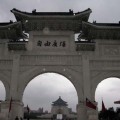
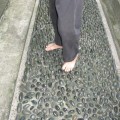
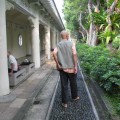
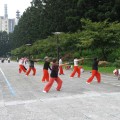
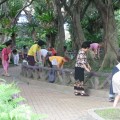
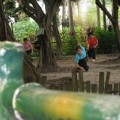
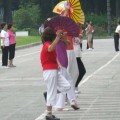
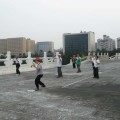
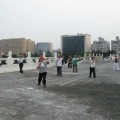
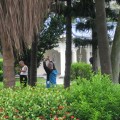
This is the kind of thing I wanted to have (for the oldies)in the Phl.
I have been teaching seminars in the Philippines for 13 years now. I do not know honestly if my teachings have influenced anybody or affected our culture in any way. Somehow, I wish that our country would have a regimen like Tai chi chuan or qigong not only for the old folks but for everybody as well. The colonial culture of the Philippines — brought to our shores during the Spanish Conquista and US Manifest Destiny — have driven us further away from Asia. Slowly, bits and pieces of Asian culture are being introduced to the Philippines — martial arts, massage, acupuncture, Chinese herbology, qigong — and are getting more popular among the middle class. I would like to see the day when groups of Filipinos, rich and poor, young and old, would gather in the parks in the morning to do their exercise routines. As a trained martial arts teacher, you can help bring this about in our hometown.